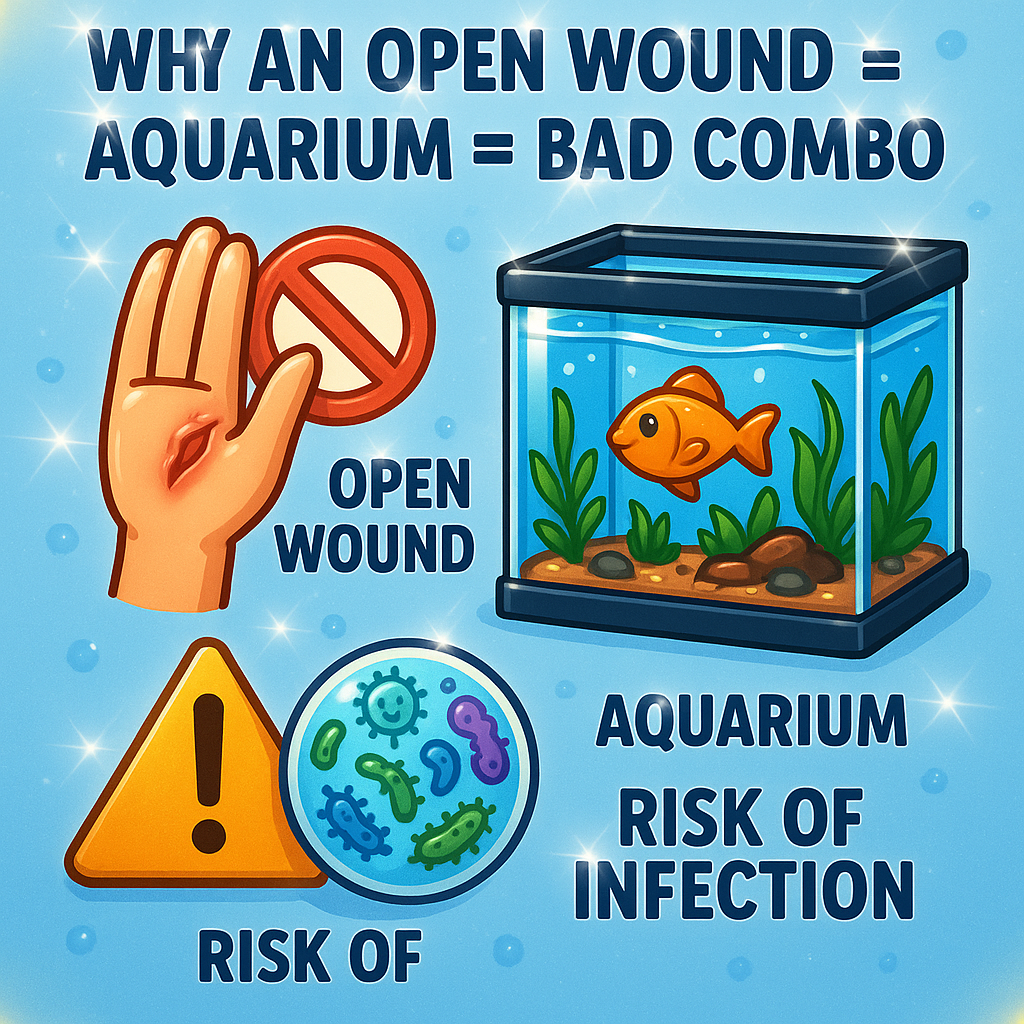Why It’s Not Safe to Put Your Hand in an Aquarium with an Open Wound
🛑 Why an Open Wound + Aquarium = Bad Combo
🧫 1) Infection risks to you
Even pristine aquaria are microbe-rich. An open cut is a doorway.
- 🧪 Freshwater culprits
- Mycobacterium marinum → “fish-tank granuloma.”
- ⏱️ Onset: typically 2–4 weeks after exposure.
- 🩹 Signs: slowly enlarging, sometimes painful nodules/ulcers on fingers/hands; can spread up the arm (sporotrichoid pattern).
- 💊 Treatment is prolonged (often weeks–months of specific antibiotics).
- Aeromonas spp., Pseudomonas spp., Edwardsiella spp. →
- ⏱️ Onset: hours–days.
- 🔥 Rapidly progressive cellulitis, swelling, blisters; may form abscesses.
- Mycobacterium marinum → “fish-tank granuloma.”
- 🌊 Brackish & marine culprits
- Vibrio vulnificus, V. alginolyticus →
- ⏱️ Very fast (hours).
- ⚠️ Can cause necrotizing soft-tissue infection, especially dangerous with liver disease or iron overload.
- Erysipelothrix rhusiopathiae, Streptococcus iniae → cellulitis/tenosynovitis.
- Vibrio vulnificus, V. alginolyticus →
- 🍄 Fungi/yeasts (secondary invaders) → chronic, slow-healing lesions.
🚑 Red flags after exposure: rapidly spreading redness, severe pain, fever, red streaks up the arm, joint pain, non-healing nodules. Seek urgent care and tell clinicians you have aquarium exposure (guides antibiotic choice).
🧍♀️ 2) Who’s at higher risk
- 🩺 Immunocompromised (chemo, steroids, HIV), diabetes, chronic liver disease, hemochromatosis.
- 🧒 Kids & older adults.
- 🧴 Eczema/dermatitis or skin breaks around nails (hangnails, torn cuticles).
🐟 3) Risks to your fish & biofilter
- 🧴 Residues from ointments, sanitizer, sunscreen, DEET, perfume, nicotine, or chlorhexidine can irritate gills, strip slime coat, and harm nitrifying bacteria.
- 🦠 Introducing new microbes from skin/wound can stress fish and seed outbreaks.
- 🧲 Bandage adhesive/loose fibers can contaminate the tank; small debris can clog impellers.
🦑 4) Extra hazards (reef & general)
- 🪸 Palytoxin (zoanthids/palythoa): contact or aerosols from scrubbing/boiling rock can cause severe eye/skin injury, breathing issues, fever. Handle with eye protection + gloves; never heat or pressure-wash.
- 🦔 Envenomation/punctures: urchins, lionfish, bristleworms, catfish spines & jagged rock → inject venom/bacteria deep into tissue.
- 🔌 Electrical safety: Always unplug heaters/pumps or use switches on GFCI-protected outlets before reaching in; wet skin + faulty gear = shock risk.
🛡️ 5) If you must work in the tank with a cut
- 🧴 Clean wound with soap & water; pat dry.
- 🩹 Cover with a waterproof occlusive dressing (film + tape).
- 🧤 Wear full-length, shoulder-length aquarium gloves (single-use inner nitrile glove + outer long glove is best).
- 🔌 Power off equipment; secure livestock away from the work area.
- 🫧 Keep submersion brief; avoid sharp rock/coral.
- 🚿 After: remove gloves carefully, wash hands/forearm thoroughly, then re-dress the wound.
- 👀 Monitor for redness, swelling, pain, drainage over the next 48–72 h.
If the dressing wets through or you got stuck/punctured: wash immediately, mark the redness margin with a pen, and seek care if it spreads.
✅ 6) Best-practice workflow (every time)
- 🎯 Rule: “No intact skin = no bare-hand tank work.”
- 🧼 Wash hands/forearms before & after (rinse thoroughly to avoid soap residue).
- 🧷 Remove rings/watches (trap bacteria, scratch glass, leach metals).
- 📦 Keep a tank-side kit: long gloves, nitrile gloves, waterproof dressings, tweezers, eye protection.
✍️ Quick takeaway
- An aquarium is a reservoir of opportunistic pathogens.
- An open wound is an open door.
- Protect you (gloves, waterproof dressings, avoid reef toxins) and protect the tank (no residues).

Impulsada por Lightspeed
Mostrar precios en:USD